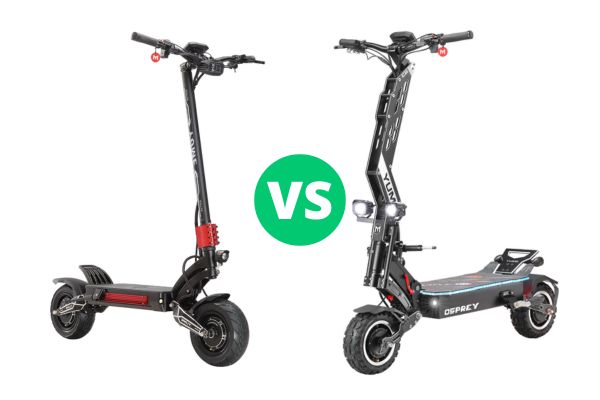The Yume Raptor and Yume Osprey are two powerful electric scooters made for high-speed performance. While both offer fast speeds and solid specs on paper, the real-world experience shows a mixed picture.
The Raptor is cheaper and serves as an entry point for thrill-seekers who want a 50 MPH scooter without spending too much. In contrast, the Osprey is more advanced, offering 60 MPH speeds and a better ride thanks to its 72V system and high-end features.
Both scooters come from Yume, a brand known for offering high specs at low prices. However, buyers must be cautious. The company has a history of quality control problems and weak customer service. Many users report problems out of the box, such as faulty parts or safety concerns. Others have ridden their Yume scooters for thousands of miles without issue.
The Raptor provides strong value for money but comes with risks like high-speed wobbles and lower reliability. The Osprey offers serious power and range, competing with more expensive hyper-scooters. But it too carries the burden of Yume’s inconsistent quality.
Yume Raptor Vs Osprey: Executive Summary Specification Showdown
| Feature | Yume Raptor | Yume Osprey |
| Price (Sale) | ~$1,640 – $1,840 | ~$2,398 |
| Top Speed | 50 MPH | 60 MPH |
| Max Range (Samsung Battery) | 60 miles | 100 miles |
| Motor Power (Nominal/Peak) | N/A / 6000W | 7000W / 10,080W |
| System Voltage | 60V | 72V |
| Battery Capacity (Samsung) | 30Ah (1800 Wh) | 40Ah (2880 Wh) |
| Scooter Weight | 90 lbs (41 kg) | 123 lbs (56 kg) |
| Max Load | N/A | 330 lbs (150 kg) |
| Brakes | Hydraulic 140mm rotors | Hydraulic 160mm rotors |
| Suspension | Non-adjustable | Adjustable Hydraulic |
| Tires | 11” Tubeless All-Terrain | 11” Tubeless All-Terrain |
| Display/Connectivity | Basic LCD | Color LCD + App + NFC |
The Power Divide: 60V Raptor vs. 72V Osprey Powertrains
The core difference between these scooters lies in their voltage systems. The Raptor runs on a 60V system, while the Osprey steps up to a more powerful 72V setup. This is more than just a number; voltage affects how efficiently the scooter delivers power.
Raptor’s System: The Raptor offers dual motors with a peak output of 6000W. It uses a Super 6 MOSFET controller that provides fast but slightly controlled acceleration. Some believe this is done to prevent stress on cheaper components.
Osprey’s System: The Osprey is on a different level. It has dual 3500W motors, reaching a total peak output of over 10,000W. This higher voltage allows stronger and longer-lasting power delivery. The acceleration is stronger and smoother, and the system is less likely to lose performance as the battery drains.
Energy and Endurance: A Battery and Range Analysis
Battery quality and capacity play a huge role in range and consistent performance. Raptor Battery: Comes with two options,27Ah (1620 Wh) and 30Ah (1800 Wh). While it claims a 60-mile range, aggressive riders often see much less, sometimes as low as 19 miles.
Osprey Battery: Offers 36Ah (2592 Wh) and 40Ah (2880 Wh) options. The top-tier battery uses Samsung 50e 21700 cells, known for quality. One rider even reported using less than half the battery after 30 miles of riding.
Charging: Both scooters include dual chargers. The Raptor takes around 4–5 hours to fully charge, while the Osprey requires about 6–7 hours due to its larger battery.
Ride Dynamics: Chassis, Suspension, and Braking Systems
A scooter’s frame and suspension matter just as much as its speed. Here’s how the two models compare:
Weight and Frame:
- Raptor: 90 lbs, single-piece aluminum frame.
- Osprey: Heavier at 123 lbs, which helps with stability but hurts portability.
Suspension:
- Raptor: Strong suspension, but not adjustable.
- Osprey: Features adjustable hydraulic suspension with 10 settings. This allows riders to tweak the ride feel based on terrain and speed.
Brakes:
- Both scooters use ZOOM hydraulic brakes.
- The Osprey has larger 160mm rotors vs. the Raptor’s 140mm ones, giving it stronger braking power and better heat management.
The Real-World Experience
Cockpit, Controls, and Usability
Every day experience is shaped by controls and design.
Display:
- Raptor: Basic LCD. Clear but lacks some info like turn signal status.
- Osprey: Full-color LCD with Bluetooth, NFC keycard unlocking, and mobile app support.
Throttle:
- Raptor: Comes with a spare throttle but is not easily swappable.
- Osprey: Includes both thumb and trigger-style throttles. Easy to swap depending on rider preference.
Portability:
- Raptor: Can be lifted into a car with effort.
- Osprey: Too heavy for easy transport. Best for riding directly from home.
Handling at the Limit: Stability, Wobble, and the Mandatory Damper
Both scooters suffer from speed wobbles, especially the Raptor. A steering damper is included, but users say it’s absolutely necessary ,not just a bonus feature.
Issues with the Damper:
- Reduces turning ability at low speeds.
- Prevents the scooter from folding properly.
- Makes parking more difficult.
These are workarounds to fix core design issues in the steering geometry. On higher-end scooters, such dampers are optional. On Yume scooters, they’re essential for safety.
The Yume Dilemma: A Frank Assessment of Quality, Reliability, and Support
This is the most controversial part of owning a Yume scooter.
Common Problems:
- Faulty parts on arrival (dead battery, broken lights, error codes).
- Screws and bolts come loose quickly.
- Serious issues like cracked frames and detached brakes have been reported.
Support Issues:
- Inconsistent customer service.
- Parts were sent out, but users must do repairs themselves.
- Long response times, especially for non-Chinese speakers.
Positive Stories Exist:
- Some owners ride their Yume scooters for thousands of miles with no issues.
- A few report strong reliability after routine checks and bolt-tightening.
The reality? Buying a Yume scooter is a gamble. You might get a solid unit, or one filled with headaches.
Market Positioning and Long-Term Value
Competitive Landscape Analysis
Here’s how the Raptor and Osprey compare to other scooters in their price ranges.
Sub-$2,000 (Raptor’s Competition):
- Solar P1 Pro: Similar speed, extra features like NFC.
- Varla Eagle One V3.0: Slower but more comfortable.
- Kaabo Wolf Warrior X GT: Slightly pricier but with a much better reputation.
$2,000–$3,000 (Osprey’s Competition):
- Nami Burn-e 2: Better quality and design, but costs more.
- Teverun Fighter Eleven: Great performance and build for the same price.
- Inmotion RS: Premium class with high waterproof rating and strong design, but nearly $3,700.
Yume Raptor Vs Osprey: Competitive Analysis Matrix
| Model | Price | Top Speed | Max Range | Peak Power | Weight | Differentiator | Brand Reputation |
| Yume Raptor | $1,640 | 50 MPH | 60 mi | 6000W | 90 lbs | Value speed | Mixed / Unreliable |
| Solar P1 Pro | $1,900 | 50 MPH | 50 mi | 4000W | 92 lbs | NFC, LED lighting | Average |
| Kaabo Wolf Warrior X GT | $1,900 | 44 MPH | 50 mi | ~4400W | 83 lbs | Dual stem, solid build | Strong |
| Yume Osprey | $2,400 | 60 MPH | 100 mi | 10,080W | 123 lbs | 72V system at lower cost | Unreliable support |
| Nami Burn-e 2 | $2,700 | 45 MPH | 90 mi | 5040W | 100 lbs | Premium build quality | Excellent |
| Teverun Fighter Eleven | $2,700 | 53 MPH | 74 mi | 5000W | 90 lbs | High-end components | Strong |
Total Cost of Ownership
Buying the scooter is just the start. Repairs, parts, and warranty limitations must be considered.
Warranty:
- Yume offers 12 months on most parts, but only 6 months on batteries, motors, and controllers.
- The buyer pays for shipping or repairs in some cases.
Consumables:
- Tires: $30–$100 each.
- Brake Pads: $10–$30 per set.
Major Repairs:
- Motors: ~$250–$300.
- Batteries: $800+.
Because of Yume’s quality inconsistencies, the risk of expensive repairs is higher than with other brands.
Final Verdict and Recommendation Matrix
Summary of Findings
Yume Raptor: Offers incredible value and speed for under $2,000. But expect to deal with build issues, wobbles, and mandatory adjustments. Best for DIY-savvy riders who love tuning and maintenance.
Yume Osprey: A budget hyper-scooter that gets close to premium performance. It brings power, range, and features usually found in pricier scooters. But again, quality concerns and weight are big trade-offs.
Rider Profile Recommendation Matrix
| Rider Profile | Priorities | Best Option | Reason | Consider Instead |
| Budget Speed Enthusiast | 50 MPH, Low Cost, DIY Ready | Yume Raptor | Cheapest 50 MPH scooter; requires self-maintenance | Solar P1 Pro, Varla Eagle One |
| Long-Range Power User | Range, Power, <$2500 Budget | Yume Osprey | Huge battery, 72V system, solid suspension | Teverun Fighter Eleven |
| Risk-Averse Commuter | Safety, Low Maintenance, Support | Neither | Yume’s reliability is too uncertain | Kaabo Wolf Warrior X GT, Nami Burn-e 2 |
| New Performance Rider | Upgrade from 30 MPH, Learning Focus | Raptor (Caution) | Less aggressive throttle, but instability is a concern | Kaabo Wolf Warrior X GT |
Conclusion
The Yume Raptor and Osprey are performance scooters that offer a lot for the price. They deliver serious speed, power, and features, often outperforming their price tag. But that low price comes with strings attached. The scooters may arrive with flaws. Repairs might fall on you. And customer service is far from ideal.
If you are mechanically inclined, have time for DIY repairs, and want a fast scooter on a tight budget, these could work. But if you want something dependable, stable, and low-maintenance, it’s worth spending more on a proven brand.
In the end, both the Raptor and Osprey are tools for experienced and adventurous riders, not for those looking for a smooth, worry-free commute. Choose wisely based on what matters most to you: cost, performance, or peace of mind.




